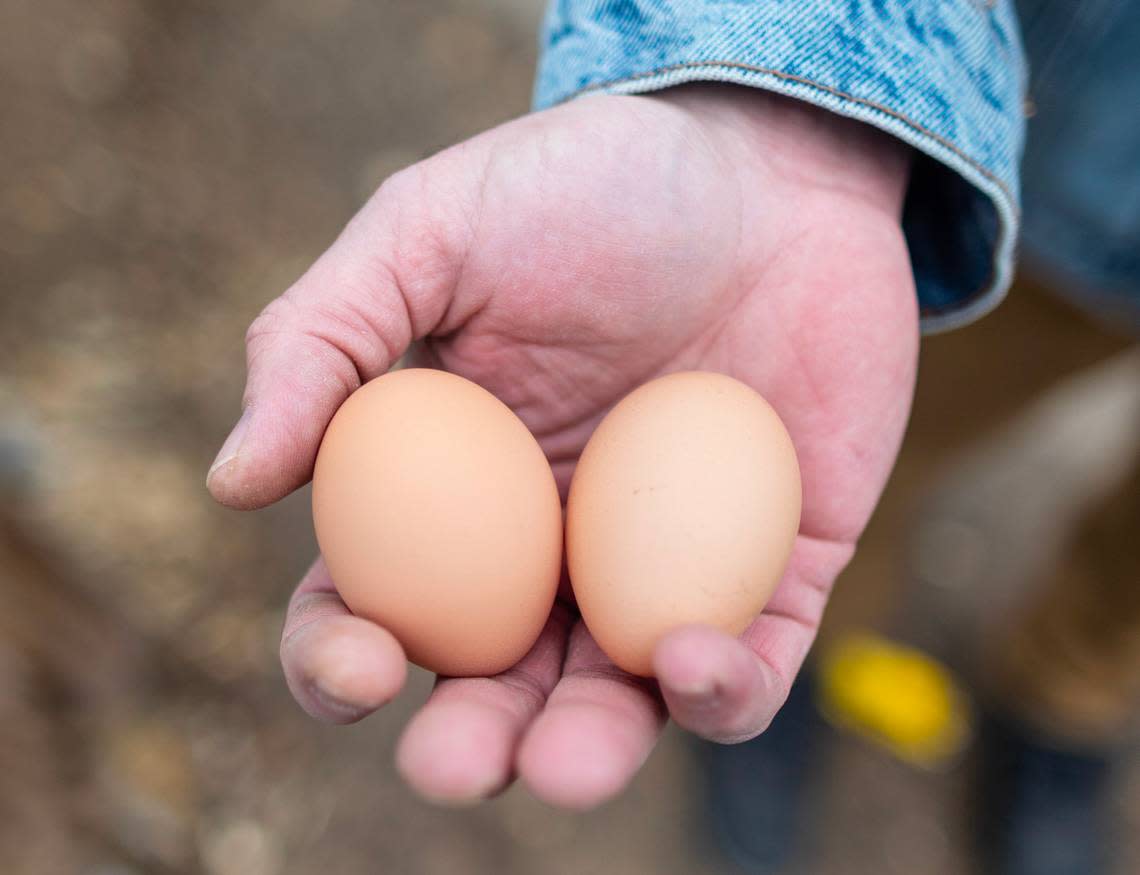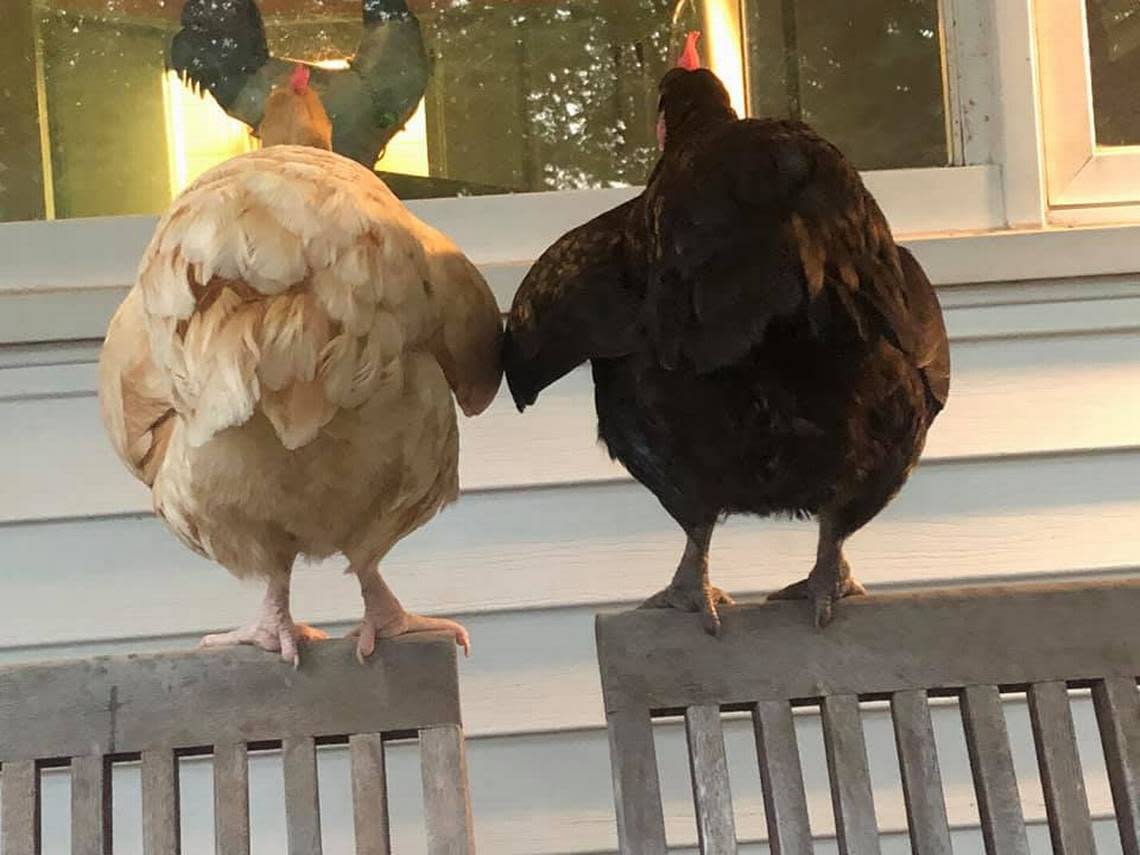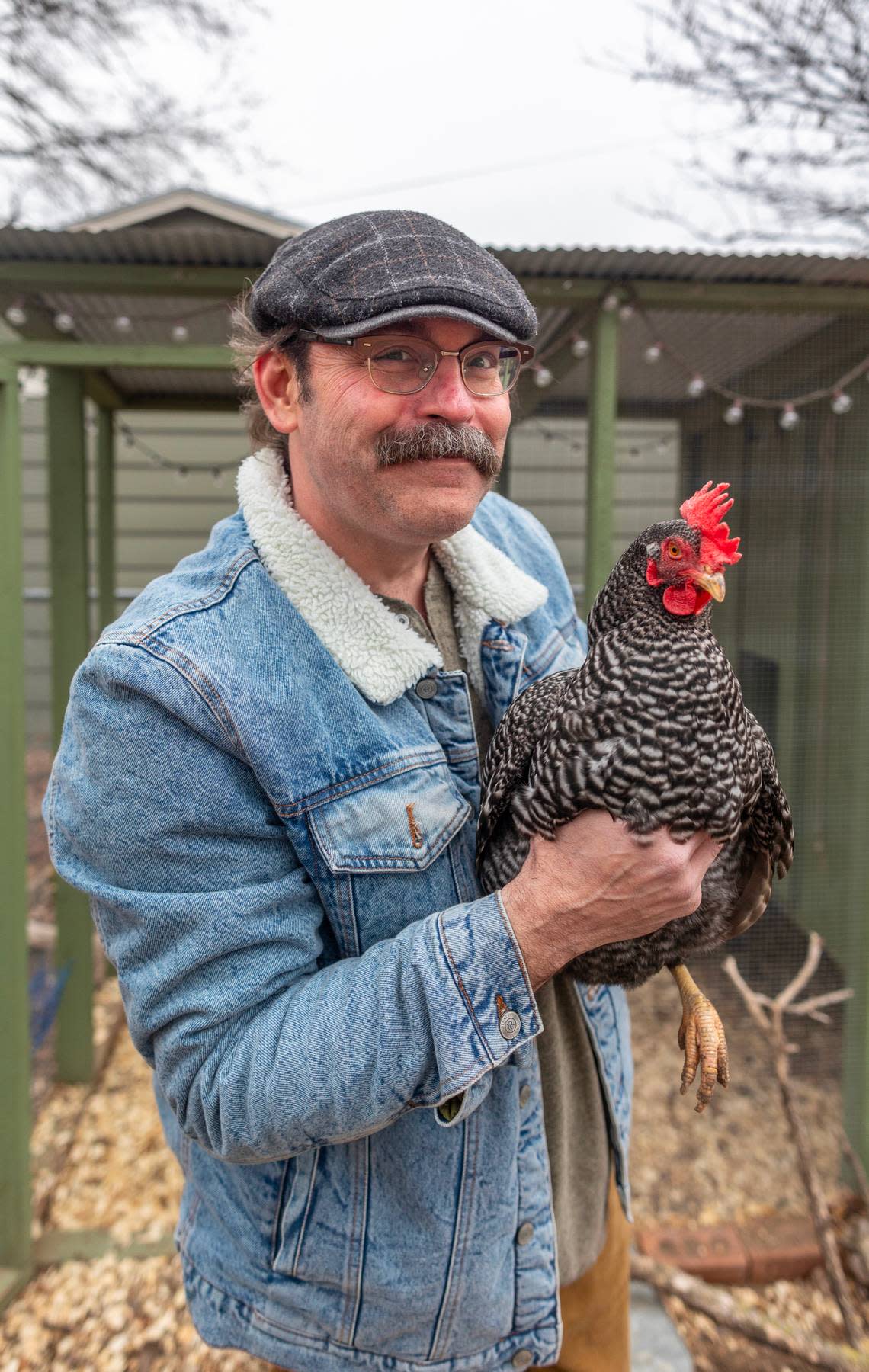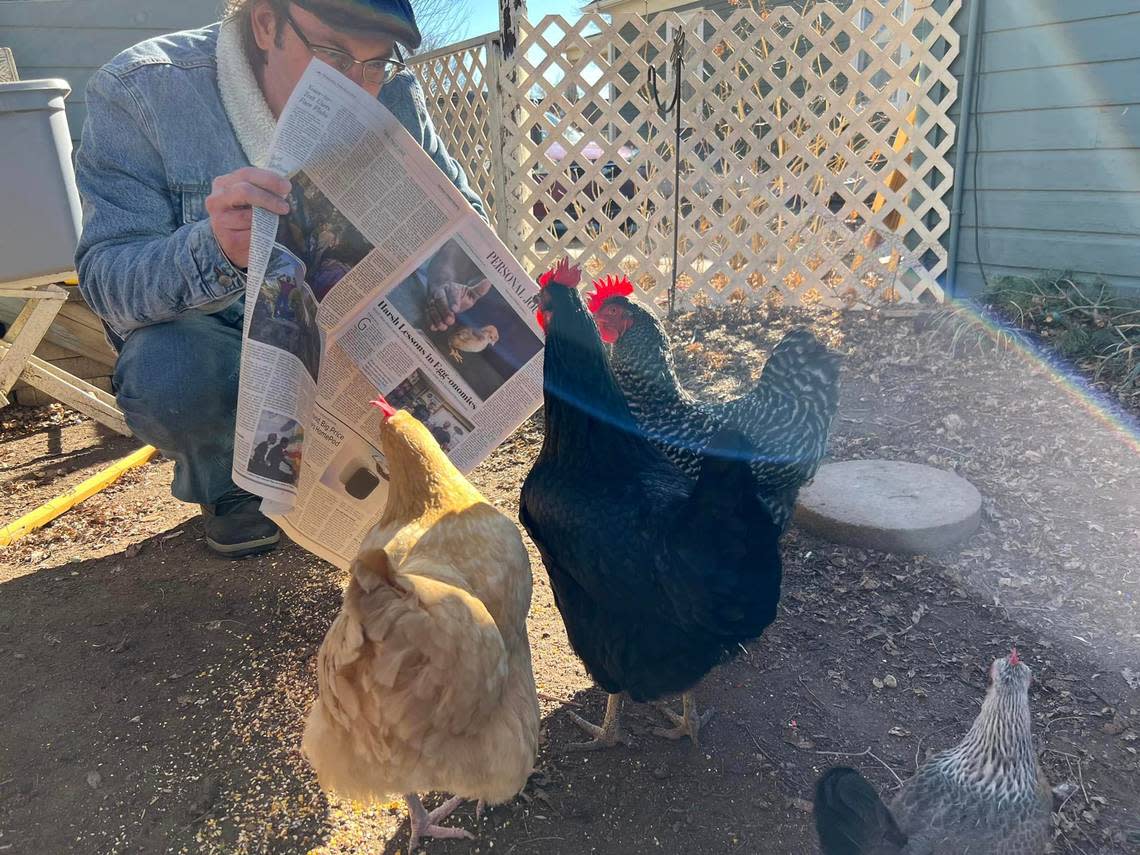So you want to raise chickens for the ‘free’ eggs? Read this cautionary tale
When people complain about the price of eggs, I have to laugh. And when they contemplate raising chickens to save on that cost, I cackle like, dare I say, a hen.
You think $6 or $7 or even $4 is a lot to pay for a carton of eggs?
Since going into backyard chicken farming in 2016, I am quite positive that my husband, Joe, and I have spent considerably more than that for the eggs our hens have produced.
My calculations are loose — and by loose, I mean I was an English major so these numbers are downright baggy — but the bottom line is not in doubt.

As the Wall Street Journal put it in a recent story headlined “Raising Chickens for Cheaper Eggs Gets Expensive Fast,” some “newbies don’t always understand the tricky logistics of maintaining a coop—and won’t necessarily break even on the price of eggs.”
Won’t necessarily break even? Who were they interviewing?
Let me be more blunt: You not only will not break even, you almost certainly are going to be spending more per egg than people pay even for organic eggs at frou-frou markets. Don’t believe me? Keep reading.
Eggciting adventure
Our chicken adventure started rather innocently and, for a brief period, not too expensively.
Joe, a cook, desperately wanted farm-fresh eggs. I don’t particularly care where my eggs come from, and I certainly didn’t want backyard chickens, but I finally relented, and the purchasing began.
There was the $300 coop — the one that one of our early batches of chickens boycotted for the better part of two years.
There were cheap — $9.99 — feeder and water systems, though we could have splurged on deluxe models that are out there for $59.99, $89.99 and even $109.99 or more. (And don’t forget the cost of the water itself, both for the girls — I keep only hens, not roosters, which aren’t allowed in the Wichita city limits — to drink and to power wash the poo they’ll leave all over your patio and sidewalks.)
Then there’s the $24.71 feed holder and the $28.49 bag of feed every other month for a mere five chickens (or three, if anyone from code enforcement is reading this).
Sure you can find chicken food for less, but these are your producers, right? You’ve got to watch that nutrition. Oh, better add $8.99 (or $41.39 for the big bag) for grit to help harden the eggshells.
Then there are the all-important mealworms, which are wonderful treats for your girls but also necessary if you’re going to stand any chance of getting them to do what you want.
I’ve paid anywhere from $35.95 to, once, $62.52. Joe would say I’m indulgent to the point of spoiling the girls. I buy a couple of bags at a time every couple of months because, to be frank, I went from not wanting chickens to falling in love with my surrogate children.

Once, I was at the Atwood’s in Derby buying mealworms when the man next to me and I realized we recognized each other due to a mutual friend. We exchanged pleasantries until I noticed the tiny bag of worms he was buying for about 7 bucks.
“Do you not love your girls?” I asked.
He laughed, perhaps stalling to figure out if I was serious, and quickly walked away.
Much, much more
So, those are some of the most basic of chicken expenses, but unless you have a hard, hard heart, you’re going to spend much, much more.
As you continue to fall in love with your birds, you’re going to want to quit serving them dinner scraps and starting buying them fresh fruits and vegetables. I can’t leave the grocery store without grapes, their favorite. Well, except for corn on the cob, the most decadent of treats. We used to throw our used cobs to the girls, but I confess, I started buying corn just for them. Lettuce is a staple as well.
We’ll put their grocery costs at a couple hundred dollars a year.
Then there was that chicken swing I just had to have that the girls ended up being scared of — $42.89 — and the colorful children’s xylophone that, according to social media, other people’s chickens just love to play. Mine never once pecked to make music or, really, even examine it. Another wasted $9.99.
Then there have been the more serious costs.
Because I don’t want Joe to know the true amount, I’ll put vet bills and medicine at about $1,000.
Still not convinced by my cautions against backyard chicken farming? Better read this
Yes, of course I take my girls to the vet. What kind of person would I be to watch one suffer?
One vet, another mutual friend, once felt so sorry for me when she had to euthanize my little Sammi that she told me to simply go and not worry about the bill. I still owe that kind woman dinner.
I guess I also need to add gas for my regular trips to Rose Hill. I make the rounds to several clinics, only one of which is in Wichita where I live, to try to catch chicken-specializing veterinarians on the days they’re in.

The ugliest expense, literally and figuratively, is the $500 for a large metal pen we had to buy to put around the coop after a tragic raccoon attack in our otherwise bucolic backyard.
Then there was the chicken wire to go around the pen and all the ties (which have to be replaced regularly as they break down in the sun) to bind it.
Even that hasn’t proven to be enough, so now, as we’re sadly chickenless again, we can’t get more girls until we figure out how to protect them better, which likely will involve a who-knows-how-expensive electric fence around the pen.
Finally, to add insult to all this financial injury, you’ve got to count all the eggs we’ve had to purchase from stores during the months our freeloading slackers — to use a term common in the backyard chicken world — weren’t producing.
You’re spending what?
Again, my figuring is on the sloppier side of approximate, but these expenses tally almost $6,000 over six years.
We haven’t kept count of the eggs our girls produced during this time, but there’s no question each one has ended up costing us more than $1 — and probably much more.
Good grief, that reminds me, I haven’t even added in what the chickens themselves cost, and that includes our accidental purchase of several roosters, who produced nothing at all except some screams from my hens. I’ll say we’ve spent about $150 or so on the actual chicken procuring.
Don’t just take my word on the math. Listen to other egg experts.
“It’s cheaper to buy them in the store,” said Leslye Woodard, co-owner of Woodard Mercantile in Maize and Andover.
And this from a woman who sells chickens.
She put in orders for baby chicks in January. There’s such a demand for chicks right now, Woodard said, “We’re on a wait list on certain ones.”
In years past, she said fancy chickens were the popular ones with shoppers.
“This year, I would say they’re more looking for layers.”
Woodard cautioned that even once the chicks arrive, it’ll be five to six months before they start laying. If your plan is to sell the eggs, she further warned that you likely won’t even be able to cover the cost of your feed.
People don’t think that through, she said.
“It’s easy to come in and buy the chicks.”
Burdensome beasts
Former KSN reporter and anchor Justin Kraemer and his wife, Leslie, learned the hassles of hens day after difficult day.
With their move to Newton in 2018, they decided to raise chickens along with their children.
“It seemed like a fun, homesteady type thing to do,” Justin Kraemer said. “The production of eggs seemed like it would be a good benefit on the side.”
While it’s been a whole lot of fun, it’s been a whole lot of work.
“It gets burdensome at times, especially when it’s freezing outside, and you’ve got to trudge out in the morning . . . and make sure their water’s not frozen and they’re not frozen. . . . And they basically reward you with nothing because you basically get no eggs the entire winter.”
The Kraemers also pay to heat their coop. Justin Kraemer, who was featured in the Wall Street Journal story about eggs, said time and labor have to be added to the final cost, too.
“I don’t even want to imagine it.”

However, Kraemer feels paternal toward his six girls — Goldie, Penny, Star, Dottie, Marigold and America.
He said each has her own personality. They’re also fun to watch, and Kraemer said he’s grown to respect the chickens and find all kinds of joy he never expected.
“It gets almost cultish.”
Woodard said she used to have chickens but no longer has time due to all her other chores. She said watching chickens is like sitting and watching a body of water.
“They’re just kind of calming.”
Kraemer said if eggs are your only reason to get chickens, though, that’s not a good enough reason.
“This isn’t going to be a cure-all to anyone’s issues.”
I could end the story there, but I’d like to give Kraemer one more chance to convince you that there are other reasons to keep chickens.
Though he said they can be “cold, unfeeling miniature dinosaurs, don’t get me wrong,” Kraemer said he loves his girls.
“It’s hard to not look at them as . . . part of the family.”
